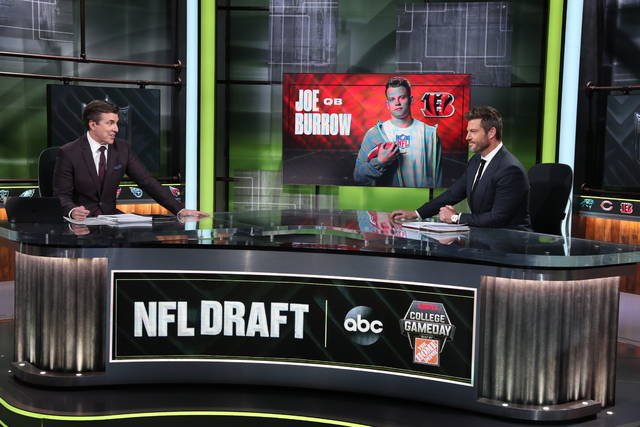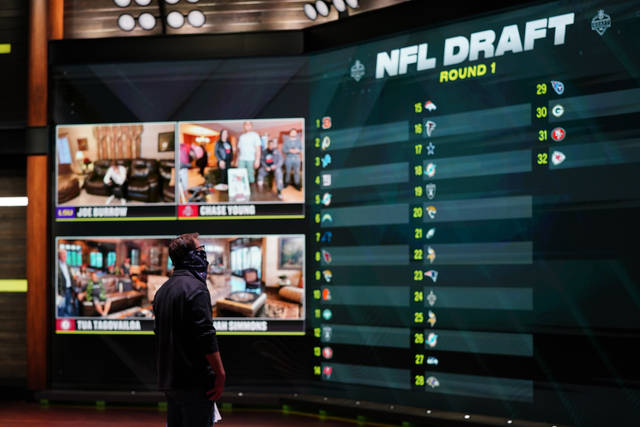

Since 2015, when the NFL began moving its draft around the nation, the event kept getting bigger and more extravagant.
Iconic backdrops in Chicago. Hundreds of thousands of fans at the “Rocky Steps” in Philadelphia or on lower Broadway in Nashville. A stadium setting in Texas, Jerry’s palace near Dallas.
Draft prospects strutting the finest (or most outlandish) of threads. Hefty bear hugs with Commissioner Roger Goodell. Entourages accompanying the new professional athletes.
This year’s proceedings in Las Vegas might have been the most lavish yet, from the scene at the Bellagio fountains to Caesars Forum.
Instead, the three-day “selection meeting,” as the league officially terms the grab bag of college talent, became a virtual experience due to the nationwide shutdown of large public gatherings because of the coronavirus pandemic. And what the NFL learned from this digital draft is that big isn’t necessarily better.
Reality TV can be an instant turnoff; how real is much of it? This draft was authentic, from the news it made in the football world to the raw emotions and passion it presented to massive audiences.
“There is always tremendous emotion around the draft,” says Peter O’Reilly, the league vice president who oversees planning of big events, including the Super Bowl. “This year, it was brought to life in such an intimate way in this format. The players with their nuclear family, and seeing those reactions to being drafted across the three days. Having cameras in coaches’ and general managers’ homes, them interacting with their kids and dogs and families.
“This came about from necessity and created a new element — to be able to bring more humanity to it, and more emotion around it. It was unique and really parallel to what was happening.”
It was refreshing, and not merely because it was the first true live sporting event of any consequence since the shutdown. Nothing seemed staged, outside of some of the requisite television shenanigans that always accompany such broadcasts. The league managed to not overplay the accompanying telethon, which raised more than $6.6 million in the three days.
Even the draft’s master of ceremonies, if you will, has gotten deserved positive reviews.
“That is who he is,” O’Reilly says of Goodell. His boss came across as the kind of guy fans would like to share a beer with while discussing the sport.
“There is no bigger and passionate fan of the game than he is, and he absolutely loves the draft and the ability to connect with draftees and former players and fans, and he is able to do that. The basement environment where, as the commissioner said, he has watched football for 30 years, and the technology was able to bring that to life.
“That is his environment. There were a lot of emotional and powerful and funny moments and he was having fun with it.”
As for the environment for upcoming drafts, given the positive vibes from this one? Therein lies the challenge for the NFL. It doesn’t relish scaling back what previously turned into a spectacle that almost rivals the Super Bowl.
But the league is faced with the stark evidence from Thursday through Saturday, born out of a scramble that would make Lamar Jackson proud, that simplicity helped carry the day. Actually, all three days.
“At least I know we can do it like this — and we did it quickly,” Chargers GM Tom Telesco says. “We put this together in roughly a month with the infrastructure, so we know we can handle it like this. There are some things I’ve done in the last month that I may incorporate next year even if it’s a regular draft — just what we did meeting-wise and what we did technology-wise. If you think about it, the way drafts have been run it’s been the same for probably 40 to 50 years, if you think about it. At least now we know we can do this a couple of different ways.”
Goodell, O’Reilly and the rest of the NFL will contemplate exactly that as they head toward Cleveland in 2021, Las Vegas in 2022 and Kansas City in 2023.
“We’re forced to adapt here and change and do this differently, but it’s actually been a lot of great learning,” Goodell said during the draft. “We’ve seen some things that we’ve maybe called stumbled on that really I think will be elements of drafts going into the future. The ability to use the virtual platforms in a way that we really didn’t think about until we were forced to, and so I think we’re really going to able to make future drafts even better because we’re going to be able to combine it with the core elements that we’ve had.
“But I think that’s one of the things about the draft, it just keeps evolving and it keeps getting better because we keep learning.”
___
AP Sports Writers Jay Cohen and Joe Reedy contributed to this report.
___
More AP NFL: https://apnews.com/NFL and https://twitter.com/AP_NFL



